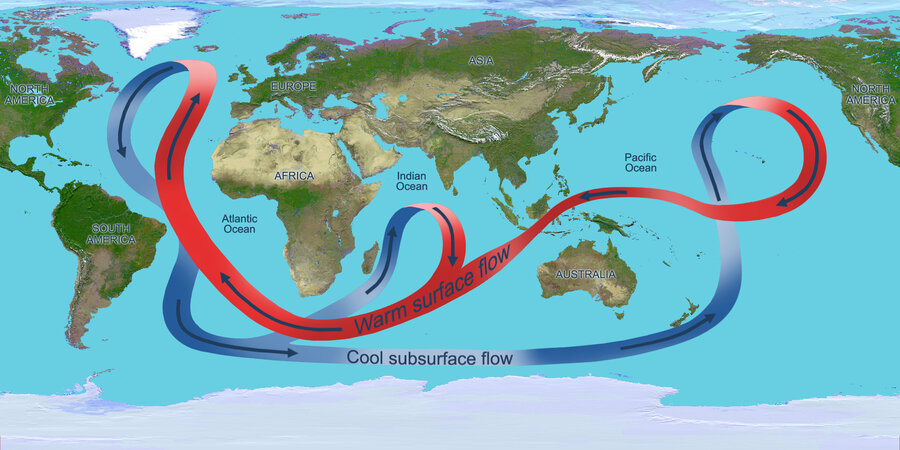Global warming 'hiatus': Scientists duel over which ocean steals some heat
Loading...
The deeper researchers dig into the dramatic slowdown in global warming during the past 15 years, the more their findings point to natural climate variability as the cause – rather than any purported end to human-triggered climate change.
The latest example of this conclusion comes from a pair of scientists from the United States and China trying to identify where the expected heat has been hiding.
They attribute the slowdown in warming, as others do, to heat taken up by the world's oceans, especially at depths below about 2,300 feet.
But the duo argues that, in a case of "right church, wrong pew," other studies have mistakenly placed the uptake largely in the western tropical Pacific.
Instead, the Atlantic and southern oceans have done the heavy lifting, say Xianyao Chen of the Ocean University of China and Ka-Kit Tung of the University of Washington.
They base their conclusion on tens of millions of measurements of ocean heat content gathered between 1970 and 2013, from the surface to depths of 5,000 feet. Their findings will be published Friday in the journal Science.
"Oceanographers have long known that the Atlantic and southern oceans are more efficient at storing heat than the Pacific," Dr. Tung says. Based on the measured distribution of heat, trade winds alone – which have blown at unusually high levels during the hiatus – aren't powerful enough to drive warm water very deep, he says.
By contrast, in the Atlantic, the heat is carried north as part of a powerful current system known as the Atlantic thermohaline circulation. The north-flowing Gulf Stream is the most visible manifestation of this circulation.
By the time it reaches the far North Atlantic, the dense, salty water has cooled and sinks. It plunges toward the seafloor and heads south at depth, retaining some of the heat it accumulated on the surface.
Tung and others have identified what they see as multi-decadal swings in the intensity of the circulation, driven by changes in the water's salinity. Fresh water is more buoyant than its salty counterpart, so when the water freshens because of changes in rainfall or snowfall patterns or because of melting Arctic ice, the circulation slows.
Tung and Dr. Chen note that a slight cooling period in global average temperatures in the mid-20th century – another pause in the longer-term warming trend – coincided with a fast phase in the Atlantic's thermohaline circulation. Indeed, plots of global average temperatures since about 1910 give climate change a stair-step look, when the current hiatus in warming is factored in.
Their conclusions, de-emphasizing the Pacific’s role, differ from others, Tung says, because he and his partner focused on measurements instead of on models or model-measurement blends. For instance, models used in some studies reproduce the variability that the duo sees in the Atlantic, but it's weaker and the swings occur more frequently than they do in the real world.
Some other studies have acknowledged an important role for the Atlantic and southern oceans as heat sinks. In a paper on the warming hiatus published on Sunday, a team led by Kevin Trenberth, a researcher with the National Center for Atmospheric Research in Boulder, Colo., noted that heat had been driven to depths of 2,300 feet or lower in those oceans.
Still, Dr. Trenberth's team concludes, the Pacific has been the center of the heat-sink action, driven largely by a natural climate swing known as the Pacific Decadal Oscillation.
Coinciding with the hiatus, the PDO has been in a phase that intensified trade winds blowing west across the Pacific. They draw warm water with them to pile up deep beneath the western Pacific, even as the winds pull deeper, colder water to the surface in the eastern Pacific.
Trenberth is not convinced that Chen and Tung have it right.
The new paper adds nice details on the heat content of different oceans, writes Trenberth in an e-mail. But, he adds, the study fails to acknowledge the long-range effect that conditions in the tropical Pacific can have on the Atlantic, nor does it reflect an understanding of the effects that those long-range "teleconnections" have on heat and water.
"What they have is not really new," he says.
Others say they see an influence from the Atlantic different from the one that Chen and Tung emphasize. In a paper published in early August, a team led by Shayne McGregor, a researcher at the University of New South Wales in Australia, reports the results of a modeling study showing how nearly 20 years of unusually warm water in the Atlantic have contributed to the unusually strong trade winds in the Pacific. In essence, air was rising over the warm waters, setting up a region of low pressure over the Atlantic and a region of falling air – high pressure – over the eastern Pacific.
"This pressure difference intensifies the equatorial Pacific trade winds, which in turn suck up colder water in the eastern Pacific and pile up warm water in the western Pacific," explains University of Hawaii oceanographer Axel Timmermann, a member of the team conducting the study.
Chen and Tung, for their part, say the hiatus in measured global warming could persist for a while longer – the effect of natural variability superimposed over the long-term warming trend.
Each phase of the variations they see in the Atlantic's thermohaline circulation lasts on average about 30 years. So Chen and Tung say the pause should last another 10 to 15 years before warming accelerates again, even if a long-predicted El Niño weather pattern in the Pacific occurs over the next 12 months.
El Niño years tend to be warmer than normal globally. Based on studies indicating that the missing heat has been pooled beneath the western tropical Pacific, many scientists have posited that the next El Niño could be a monster as trade winds relax and the large pool of warm water sloshes back eastward.








